Puzzles
In my mind a "puzzle" differs from a "game" in that the former is designed to be pretty much a solitary exercise, while the latter is meant to engage two or more people in some sort of competition. On this page I'm listing various puzzles that I have invented. They are heavily leaning toward the mechanical and geometric type of puzzle.One of the joys for me, as a designer, is to figure out how these are best made (what material and so forth). I generally try to create prototypes that can be made simply and quickly, drawing upon the resources I have handy.
I often end up selling copies of these to friends (especially during the holidays) when they are looking for one-of-a-kind gifts.
Trickier than actually creating interesting puzzles seems to be naming them. As mentioned under the "Jimmy Cube", I offered to let the first person who solved a new puzzle name it. But I'm not sure if I'm going to strictly adhere to this. After solving the Jimmy Cube at the local coffeeshop, said solver, Jimmy, couldn't really think of a name he was completely happy with. One possibility was "The Wei" or "The Way" (a play on his first name), or, poking fun at fellow cafe-goer, Mary, who did not solve it, he thought of "The Mary Couldn't Do It Puzzle".
But this is led to unforeseen consequences, as Mary (though not solving it) later suggested I name 8CTO "Jimmy Is A Punk-Ass".
Maybe I will just come up with my own names...
Encaged
2006 Pentomino Daily Calendar
Not exactly a hand-crafted, manipulative puzzle, but related nonetheless. People interested in geometry, games, and puzzles, might be interested in my compilation of pentomino challenges in the form of a Daily Calendar. Even though we are past 2006, this item may intrigue you if you would like 365 pentomino puzzles to solve.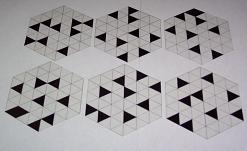
Eclipse
This puzzle is a set of 6 hexagonal pieces. Each is made of thin, clear plastic and is partitioned into 54 triangles. On each piece 9 of those 54 triangles are colored in black. The object is to stack the six hexagons atop one another so that the whole shape is filled in by the black triangles (i.e. no triangles remain clear all the way through the layers).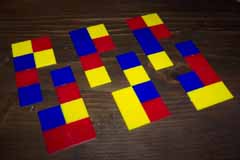
Hexerei
This is basically a smaller version (and simpler version) of 8CTO (below). It uses only 3 different colors, and a 6x6 square is formed with the pieces, not an 8x8.
Here is one solution. I do not know how many non-trivially distinct solutions there may be.

8CTO
This is a puzzle consisting of 8 rectangular pieces, each 2x4 colored unit squares. The squares are colored plastic (red, blue, yellow, or green). The object is to assemble them into an 8x8 square such that each row and column has exactly two squares of each color. The unit squares are 1" by 1", so the final solution measures 8 inches square.The solution is not unique. Here is one answer. I do not know how many non-trivially distinct solutions there may be.
Jimmy Cube
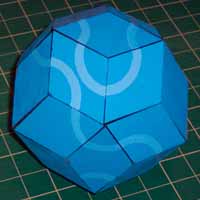 Ok, first off, I know that this puzzle is not a cube. However, as friends of mine were playing with the prototype, I started a "competition" by saying whoever solved it first could name it. After several folks tried unsuccessfully to assemble the 30 rhombic pieces into a single polyhedron with the painted line forming one continuous loop, friend, Jimmy, finally succeeded.
Ok, first off, I know that this puzzle is not a cube. However, as friends of mine were playing with the prototype, I started a "competition" by saying whoever solved it first could name it. After several folks tried unsuccessfully to assemble the 30 rhombic pieces into a single polyhedron with the painted line forming one continuous loop, friend, Jimmy, finally succeeded.
While he was celebrating his triumph, someone off-handedly referred to the puzzle as "the Jimmy Cube". So, until Jimmy comes up with a better name, that's going to stick.
Besides, it's easier to say than "Jimmy's Rhombic Triacontahedron".
The model pictured here is made of spruce wood (I needed light weight) with embedded magnets. It is hand painted.
Colored Icosahedron, Easy Version
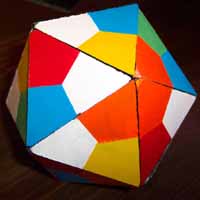 Built in a similar fasion as the Jimmy Cube above (with magnets embedded in the sides of wooden pieces), this puzzle, when completed, has twenty sides, not thirty. The goal is to arrange the pieces so that the colored sections at the vertices match. There are twelve vertices on a regular icosahedron, so I painted it such that there would be 6 pairs of colors (red, white, green, yellow, blue, and orange).
Built in a similar fasion as the Jimmy Cube above (with magnets embedded in the sides of wooden pieces), this puzzle, when completed, has twenty sides, not thirty. The goal is to arrange the pieces so that the colored sections at the vertices match. There are twelve vertices on a regular icosahedron, so I painted it such that there would be 6 pairs of colors (red, white, green, yellow, blue, and orange).
This is an easier version of a related puzzle I built, which I will document later.
Colored Icosahedron, Hard Version
 The same shape as the puzzle above (20-sided), this one is painted differently. The goal is to arrange the pieces so that the colored sections at the edges match.
The same shape as the puzzle above (20-sided), this one is painted differently. The goal is to arrange the pieces so that the colored sections at the edges match.
Because there are many more edges than vertices, and of the independence of the edges' orientations to one another, this puzzle is significantly more difficult than the "easy" icosahedron above.
Surface Mazes
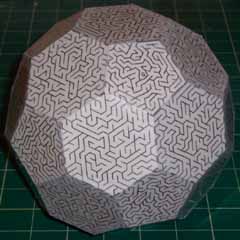 I also enjoy creating mazes. Recently I've been focusing on creating mazes on the surfaces of various geometric shapes (or, more accurately, I've been focusing on creating computer programs which generate random mazes of the surfaces of geometric shapes). Pictured to the right is a maze on the surface of a "buckyball" (i.e. a truncated icosahedron, or soccer ball).
I also enjoy creating mazes. Recently I've been focusing on creating mazes on the surfaces of various geometric shapes (or, more accurately, I've been focusing on creating computer programs which generate random mazes of the surfaces of geometric shapes). Pictured to the right is a maze on the surface of a "buckyball" (i.e. a truncated icosahedron, or soccer ball).
The maze is "perfectly formed", meaning that there are no loops, and every spot on the maze is reachable from every other spot on the maze. This is really just a prototype; I plan to make a nicer one with a solid wood structure beneath the laminated paper surface. The pictured one is simply heavy paper laminated with clear contact paper and taped at the edges of tha faces. The laminate allows one to use an erasable marker on the surface when solving.
I created a maze on the surface of a cube for my first Puzzle Party back in fall of 2004. I did not have one at EPP2, but I expect similar puzzles to crop up again at future Parties.
Color Cube
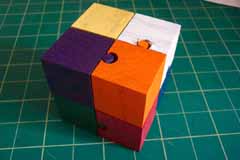 Pictured here is a rough prototype of a cubic puzle I designed. The cube can be separated into 8 subsections (they slide together with tongues and grooves). This model is fashioned out of wood, and painted.
Pictured here is a rough prototype of a cubic puzle I designed. The cube can be separated into 8 subsections (they slide together with tongues and grooves). This model is fashioned out of wood, and painted.
I hope to make later ones smoother and with a higher degree of precision so that the tongues and grooves fit more snugly. I will also paint the blue section a lighter blue so that it is easier for me to tell it apart from the purple section.
Explore
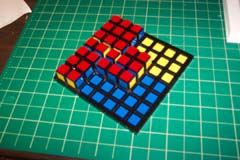 This puzzle was my entry in the 2005 Nob Yoshigahara Puzzle Design Competition (formerly the IPP Design Competition). I have a webpage devoted exclusively to this puzzle. It is a somewhat "open-ended" challenge in that the best possible answer is not immediately obvious (in fact, I still do not know if the best answer so far obtained is the theoretic optimum).
This puzzle was my entry in the 2005 Nob Yoshigahara Puzzle Design Competition (formerly the IPP Design Competition). I have a webpage devoted exclusively to this puzzle. It is a somewhat "open-ended" challenge in that the best possible answer is not immediately obvious (in fact, I still do not know if the best answer so far obtained is the theoretic optimum).
Despite this goal-ambiguity, I very much enjoy this puzzle as I feel it encourages the player to simply manipulate the pieces and try to discover interesting configurations... thus the name.